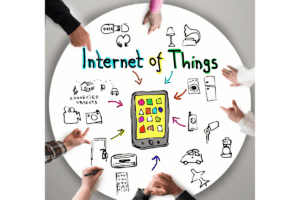Effective Meeting Minutes: How to Write a Meeting Summary
Ever felt overwhelmed trying to recall what was decided in last week’s meeting? You’re not alone; capturing what transpired in a meeting is crucial yet challenging. This blog offers step-by-step guidance on creating effective meeting minutes that captures all the essential discussion points and takeaways.
Get ready to transform your note-taking skills and never miss a beat!
Key Takeaways
- Meeting Minutes are important records of what was talked about and decided in a meeting.
- Project Management Meeting Minutes are typically a Hybrid between Action and Discussion Minutes
- Good meeting summaries should have the main points, actions that need to happen, who is doing them, and when they should be done.
- Sharing your summary with everyone quickly helps keep all team members on the same page.
- Free Meeting Synopsis template included in the article below.
Understanding the Purpose of a Meeting Minutes

Meeting minutes serve as the official record of what was decided and discussed at a meeting. They are important because they help people remember what happened. If you have to write meeting minutes, you’re keeping track of everything for those who were there and those who could not make it.
These notes are like a map. They guide everyone on the team about what needs to be done next.
Outlined in the book Robert’s Rules of Order (affiliate link to book on Amazon), Meeting Minutes are critical for official record-keeping and future reference.
When you capture these minutes either during or right after your meeting, you keep the details fresh. This helps everyone stay clear about their tasks and deadlines. The best part is if someone has questions later or if there’s a new person on the team, they can read your notes to catch up quickly.
Your job when writing these records is like that of a storyteller. You tell the story of the meeting with enough detail so others understand, but without any extra stuff to confuse them.
It’s also good practice to distribute them quickly while it’s all still in people’s minds.
What are the Main Types of Meeting Minutes?

In crafting your meeting summary, remember it’s a strategic tool—a beacon guiding stakeholders through the project’s progress. Distill the essence of your discussions into a digestible, action-oriented document, sparking clarity and momentum. Embrace this practice as a powerful ally in your communication arsenal; it can turn an ordinary meeting into a springboard for success. Celebrate the completion of a well-executed summary, knowing it’s more than just notes—it’s the roadmap for your team’s journey ahead. Keep it concise, clear, and full of purpose, and watch as it elevates your project management to new heights.
Selecting the right type of minutes depends on the meeting’s nature and the organization’s specific needs.
Types of Minutes
There are 3 main types of meeting minutes; Action minutes, Discussion minutes, Verbatim minutes. Below is a bulleted list of each and how they are used.
-
Action Minutes:
- Focus: Primarily on the decisions made and actions agreed upon during the meeting.
- Usage: Ideal for meetings focused on decision-making and task assignment. Action minutes are succinct, listing action items, responsible individuals, and deadlines.
- Benefit: Facilitates tracking of progress and accountability, ensuring that decisions lead to tangible outcomes.
-
Discussion Minutes:
- Focus: Capturing the essence of discussions, including various viewpoints, arguments, and deliberations.
- Usage: Suited for meetings where the discussion process is as important as the outcome, such as brainstorming sessions, strategy meetings, or complex decision-making scenarios.
- Benefit: Provides a comprehensive record of the discussion, offering insights into the reasoning behind decisions and preserving the diversity of opinions.
-
Verbatim Minutes:
- Focus: Transcribing every word spoken during the meeting, exactly as said.
- Usage: Necessary in formal settings like board meetings, legal proceedings, or situations where an exact record of the conversation is required for compliance or historical purposes.
- Benefit: Ensures an accurate and detailed account of the meeting, crucial for legal documentation and historical reference.
Steps to Write an Effective Meeting Minutes for Projects

When writing an effective meeting minutes, it’s important to take detailed notes, highlight key points or discussions, add clear action items, include key takeaways at the bottom, attach supporting documents if necessary, and share the summary with all stakeholders.
These steps will ensure that your meeting summary is comprehensive and useful for all involved.
The following article will concentrate on a meeting synopsis format. A meeting synopsis is a hybrid approach that blends Action and Discussion Minutes. This style of meeting notes is commonly preferred by Project Managers for their meeting recaps
Detailed vs Concise note taking
Taking notes in a meeting is like packing for a trip. You want to bring everything you need, but not so much that it weighs you down. When writing an effective meeting summary, think about what the team must remember.
This means choosing between detailed or concise notes.
Detailed notes are full of information. They include everything said and done in the meeting. But too many details can make things confusing.
Concise note-taking is different. It’s like drawing a map with just the places you’ll visit marked on it. You write down only the important parts: decisions made, action items, who will do what by when, and key points discussed.
Highlighting key points or discussions
After taking meeting notes, the next step in writing an effective meeting synopsis is to highlight key points or discussions. This involves identifying the most important topics and insights from the meeting and presenting them clearly in the summary.
By emphasizing these key points, you ensure that stakeholders can quickly grasp the essential information without getting lost in unnecessary details. Highlighting key discussions helps keep the meeting synopsis focused and impactful, providing a clear understanding of what transpired during the meeting.
To make sure that nothing important gets overlooked, it’s crucial to use headings, subheadings, bullet points, colors, or any other formatting techniques to draw attention to significant discussions and decisions made during the meeting.
Adding clear action items
After highlighting the key points or discussions, the next crucial step in writing an effective meeting summary is adding clear action items. These action items should be associated with decisions made and key takeaways from the meeting.
It’s important to articulate these action items clearly and concisely so that stakeholders understand what needs to be done moving forward. Utilizing tools like Notta’s AI Summary Generator or Bit.ai can streamline this process by automatically creating a condensed transcript version that includes clear action items associated with the discussion points.
Crafting a well-written meeting synopsis involves ensuring that your meeting summaries include essential components such as main topics, key points, decisions, and clear action items.
Including key takeaways
When crafting a meeting summary, be sure to include key takeaways at the end. This is crucial for providing a clear understanding of the main points and outcomes discussed during the meeting.
By highlighting the essential information in this way, stakeholders can quickly grasp the most important aspects without having to sift through lengthy documentation. Keeping it concise and accurate effectively communicates vital information and ensures that everyone is on the same page after the meeting.
Remember, clear action items should also be included in your meeting synopsis – this lets stakeholders know what needs to be done going forward.
Attaching supporting documents (optional)
Including supporting documents such as emails, contracts, and project instructions in the meeting summary is beneficial. It ensures that all necessary information is easily accessible to attendees.
Adding related articles or blogs can provide additional context and clarity for everyone involved in the meeting discussions. This enhances understanding and collaboration among team members, making it easier to address any issues or action items decided upon during the meeting.
Proofreading and editing
After attaching supporting documents, it’s crucial to dedicate time for proofreading and making necessary edits to ensure that the meeting synopsis is accurate and clear. Utilizing AI and automation tools can significantly enhance the accuracy of meeting summaries while streamlining the process.
By emphasizing proofreading, you can avoid errors in action items or key takeaways, ensuring that stakeholders receive an effective meeting synopsis with no room for misinterpretation.
This attention to detail fosters better communication and decision-making among project professionals and new project managers.
Sharing the meeting synopsis with stakeholders
Once the meeting synopsis is ready, it’s essential to share it promptly with all stakeholders. Sharing the document ensures that everyone is on the same page and can take necessary action if needed.
Using collaboration platforms like Google Docs or Microsoft Word allows for easy access and feedback from all participants. AI-generated summaries such as Notta can also aid in sharing accurate and efficient documents with stakeholders for better understanding of key decisions and action items discussed in the meeting.
Remember, the ultimate goal of sharing the meeting synopsis is to provide a clear, concise, and informative resource for everyone involved in the project. This transparent communication helps in driving progress by ensuring that all team members are aligned on their responsibilities and objectives moving forward.
Essential Components of an Effective Meeting Summary

Include main topics and key points, decisions and action items, as well as any supporting documents and references that were mentioned during the meeting. Crafting a thorough meeting summary allows for better follow-through on action items and keeps all stakeholders informed.
For more insights on how to write an effective meeting summary, keep reading!
Main topics and key points
Meeting summaries are a condensed version of the important discussions and decisions made during a meeting. They usually include the main topics discussed, key points, decisions, and action items.
Including background information or previous discussions related to the main topics can provide context in a meeting synopsis. Keeping the summary concise while highlighting the essential components is crucial for effective communication with stakeholders.
Understanding how to write an effective meeting synopsis involves detailed note-taking, highlighting key points or discussions, adding clear action items, including key takeaways, and proofreading before sharing it with stakeholders.
Decisions and action items
When writing a meeting synopsis, it’s essential to include clear action items for stakeholders to follow up on after the meeting. This helps ensure that everyone is aware of their responsibilities and tasks moving forward.
By clearly outlining decisions made during the meeting and assigning specific actions, you can drive progress and accountability within your team.
Incorporating these key components into your meeting synopsis not only provides a record of what was discussed but also facilitates effective follow-up and implementation of important decisions.
Supporting documents and references
When creating a meeting summary, it can be helpful to include supporting documents and references that provide additional context or details about the discussed topics. These documents may include presentation slides, data reports, or relevant articles that were referenced during the meeting.
By attaching these materials to the meeting summary, project professionals and new project managers can ensure that stakeholders have access to comprehensive information related to the meeting discussions.
This practice promotes transparency and clarity in communication, allowing all involved parties to stay well-informed about important decisions and action items.
Furthermore, incorporating supporting documents and references also serves as a way to create an official record of the meeting that can be referred back to in the future if needed.
Meeting Minutes Template: Meeting Synopsis for an Effective Meeting Summary
Heading
This provides the historical refence to the content captured in the meeting. It is a combination of the Title and date of the meeting.
Invitees
This section lists all individuals who were invited to the meeting. It’s a good practice to differentiate between those who were invited and those who actually attended the meeting. This provides clarity on who was expected to be part of the discussion and decision-making process.
Example:
- Invited: John Doe, Jane Smith, Alex Johnson
- Attended: John Doe, Jane Smith
Discussion Points
Here, you summarize the key points discussed during the meeting. This section should align with the meeting agenda and cover the main topics in a concise manner. It’s important to capture the essence of the discussions without getting bogged down into too much detail of the entire meeting.
Example:
- Discussion on quarterly sales targets
- Review of new marketing strategies
- Feedback on product development progress
Key Takeaways
This section highlights the most important outcomes and insights from the meeting. It’s where you distill the essence of the discussion into actionable insights. This could include major decisions made, insights gained, or shifts in strategy.
Example:
- Agreed to increase Q2 sales targets by 15%.
- Identified need for a more aggressive social media marketing strategy.
- Decided to prioritize feature X in the next product update.
Next steps
This critical section outlines the specific actions to be taken following the meeting. It’s a roadmap for what needs to happen next. Each action item should be clear and actionable, with a designated person responsible for its completion.
Example Table:
| Action Item | Responsible Person | Deadline |
|---|---|---|
| Finalize Q2 Sales Report | John Doe | April 15, 2023 |
| Develop Marketing Plan | Jane Smith | April 22, 2023 |
| Update Product Roadmap | Alex Johnson | April 30, 2023 |
Template: Meeting Synopsis
You can use the free template below if you wish. Just copy the format into an email, complete it with your meeting notes, and send out after your next meeting.
Meeting Heading
- Heading: [Insert Meeting Title] – [Insert Date of Meeting]
Invitees
- List of Invitees: [List all individuals invited to the meeting]
- [Name 1]
- [Name 2]
- [Name 3]
- […]
- Attendees: [Optional: List actual attendees if different from invitees]
- [Name 1]
- [Name 2]
- [Name 3]
- […]
Discussion Points
- Item 1: [Brief summary of discussion points]
- [Key Point 1]
- [Key Point 2]
- […]
- Item 2: [Brief summary of discussion points]
- [Key Point 1]
- [Key Point 2]
- […]
- [Continue with other items as necessary]
Key Takeaways
- Takeaway 1: [Key outcome or conclusion from the meeting]
- Takeaway 2: [Key outcome or conclusion from the meeting]
- [Continue with other key takeaways as necessary]
Next Steps
|
Action Item |
Responsible Person |
Deadline |
|
[Action 1] |
[Name of responsible individual or team] |
[Due Date] |
|
[Action 2] |
[Name of responsible individual or team] |
[Due Date] |
|
[Action 3] |
[Name of responsible individual or team] |
[Due Date] |
|
… |
… |
… |
Meeting Minute Challenges
 Writing meeting minutes can be tough. You try to catch every detail, but sometimes things move fast. People talk over each other, and important points might get missed. Keeping up can feel like a race, especially if you’re new to taking notes.
Writing meeting minutes can be tough. You try to catch every detail, but sometimes things move fast. People talk over each other, and important points might get missed. Keeping up can feel like a race, especially if you’re new to taking notes.
You might also face challenges with what to include in your notes. Figuring out the key parts of the discussion is not always clear. And after the meeting ends, putting it all into a neat summary takes more effort.
It’s about making sure nothing gets lost or misunderstood by those who count on your minutes to know what happened.
Utilization of AI and Automation Tools for Meeting Summaries
Utilizing AI and automation tools can significantly improve the efficiency and accuracy of meeting summaries. These tools can swiftly analyze discussions, extract key points, and generate concise meeting summaries.
By leveraging natural language processing (NLP), these AI systems can identify essential details, such as action items and decisions made during the meeting. Not only do they save time, but they also ensure that crucial information is not overlooked, offering project professionals and new project managers a reliable way to capture the most pertinent aspects of their meetings.
As we delve into the benefits of AI-generated meeting summaries, it becomes evident that embracing these advanced technologies can streamline the entire process while delivering comprehensive and precise documentation.
Example of a Meeting Summary

Now, let’s dive into an example of a meeting summary that encapsulates the essential components we’ve discussed. Imagine you just wrapped up a pivotal project discussion with your team.
Your meeting summary should highlight key decisions and action items agreed upon during the meeting. It would also include any supporting documents or references such as slides or reports shared during the session.
This example can serve as a template for creating effective meeting summaries in your professional endeavors.
What are the meeting summary key points?
The key points of a meeting summary are to provide a condensed version of the main topics and decisions from the meeting. This includes highlighting key points or discussions, adding clear action items, including key takeaways, and attaching supporting documents if needed.
It’s important to share the summary with stakeholders and ensure that it is concise and accurate. Using AI and automation tools can also enhance the efficiency of creating meeting summaries by generating real-time transcripts and summarizing lengthy texts.
AI-powered tools like Notta.ai can simplify this process by recording meetings, transcribing them in real-time, and condensing lengthy information into manageable summaries. These summaries are valuable for sharing essential information with project professionals and new project managers in a clear format.
What is a good meeting format?
To ensure an effective meeting, a well-structured format should be shared with attendees before the meeting. This format can include the agenda and any pre-reading materials, giving participants clarity on what will be discussed and allowing them to come prepared.
Additionally, having a clear meeting objective and ensuring that each item on the agenda aligns with this goal can help maintain focus throughout the discussion. Setting time limits for each topic can also aid in keeping the conversation productive and within schedule.
Encouraging active participation from all members ensures that diverse perspectives are considered, leading to comprehensive decision-making.
FAQs
1. What’s the difference between meeting minutes and a meeting summary?
Meeting minutes are an official record of everything that happened in the meeting, while a meeting summary gives you just the main points discussed.
2. How do I write a good meeting summary?
To write a great meeting summary, start by listing key points from your notes taken during the meeting. Include actions items and decisions made.
3. Can AI help me with creating my meeting summaries?
Yes, an AI meeting assistant can quickly turn your notes into well-structured outlines for effective summaries or even offer ai-generated content when needed.
4. What should I include in my quick meeting summary?
Your quick recap should cover what was talked about, any decisions made, tasks assigned, and what to expect for the next gathering.
5. Where can I find examples or templates for writing my own summaries?
Look online for free templates or examples to guide you in crafting effective recaps of your meetings.
6. Are there tools to capture every part of my formal meetings accurately?
Absolutely! For full accuracy use tools like OneNote or Evernote which help you keep track and share all that occurred without missing anything important.
Conclusion
In conclusion, writing a meeting synopsis is important for project professionals and new project managers. It provides a condensed version of the meeting’s key points, making it easier for stakeholders to obtain essential information.
By following the outlined steps and understanding the purpose of meeting summaries, one can effectively create concise and impactful recaps. Utilizing AI and automation tools also enhance efficiency in summarizing meetings.
Remember that an effective meeting synopsis includes main topics, decisions, action items, supporting documents, and references.
If you liked this article, remember to subscribe to MiamiCloud.com. Connect. Learn. Innovate.






